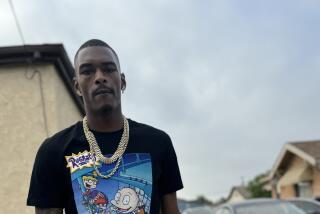Reggae/Rapper Shinehead Reaches for Wide Audience
- Share via
If the old distinctions between reggae, rap and pop are tumbling down, you can give a lot of the credit to Shinehead.
The reggae/rap vocalist, who was born in Jamaica and has lived in New York since 1976, created a stir last year with his category-defying “Unity” album, which blended the Beatles’ “Come Together” with snippets of “We Shall Overcome,” Bob Marley and Sam Cooke, and radically revamped contemporary reggae hits and old soul material.
The record helped Shinehead (nee Edmund Carl Aiken) win a diverse audience--something he views as a reflection of the current musical climate.
“Other people might find it strange that people of totally different ethnicities from me like my music, but they’re not out on the streets like I am,” said Shinehead, who performs at the Reggae Splash Festival at Cal State Dominguez Hills on Sunday. The show, headlined by Yellowman and emphasizing reggae’s dance-hall style, starts at noon.
Shinehead’s versatility stems from his early exposure to such pop artists as the Beatles, Tom Jones and country singer Marty Robbins, rather than reggae or heavy funk performers. Shinehead continued absorbing influences from a wide array of artists after his family moved to New York when he was 13. And any music that fit his ideas was fair game. “I’m an equal opportunity employer,” he quipped.
But he was strictly a fan until his mother surprised him with a microphone as a 19th birthday present. Shinehead joined forces with the Bronx-based African Love Music sound system and began playing at concerts and parties. He soon faced a choice between his engineering studies and the entertainment world.
Recalled Shinehead: “I dropped out of college after 2 1/2 years and said, ‘Are you going to graduate and get a job in the corporate world, work for 20 years and retire with a gold watch, or go down the uncertain road of show business?’ It was a pretty tough decision, but it was love and determination that took me this far.”
Shinehead released his first album, “Rough and Ready,” on the independent African Love label in 1986. It took off in the Northeast when his version of Bob Marley’s “Who the Cap Fit” got substantial airplay on black radio--a format that’s usually unreceptive to straight reggae.
Shinehead blames a language barrier for the perception of the reggae and the R&B; audiences as separate camps.
“If I speak like a Mexican or Puerto Rican or Englishman,” said Shinehead, his voice dropping into a short example of each dialect, “and get as close as possible to the way they sound, I stand a better chance of communicating. You’re lucky to get by with a beat if somebody doesn’t understand what you’re talking about.”
But one of Shinehead’s goals remains mixing and matching styles to bridge the gap between the Jamaican and black American audiences. On the “Unity” album, “Hello Y’all” combined a rap-style vocal with hard reggae rhythms. “Know How Fe Chat” reversed the equation by setting a patois-laden Jamaican vocal against a funk arrangement.
While rap and especially reggae form the twin bases for Shinehead’s style, “Gimme No Crack” incorporated a Marty Robbins melody, and “Chain Gang-Rap” turned the Sam Cooke chestnut into an excursion on a New York subway system. The title track used “Come Together” as a launching pad for a plea to rappers to stop the popular “dissing” (put-down) contests.
“I was always one to go against the grain and break all those so-called rules,” said Shinehead. “I was always oddball. Now that everybody else is ‘dissing’ (rap slang for showing disrespect), I’m trying not to because it’s just not me.
“ ‘Dissing’ is big business, like it or not, but if we concentrated on the real adversaries who really don’t like rap or your so-called underground music, people would be more receptive to it. Even those who didn’t like us would have to swallow that and give us some respect.”
More to Read
The biggest entertainment stories
Get our big stories about Hollywood, film, television, music, arts, culture and more right in your inbox as soon as they publish.
You may occasionally receive promotional content from the Los Angeles Times.









